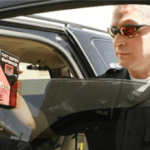OPINION
Per Curiam.
A confidential informant advised the police that claimants Darryl Keith Sewell and Anthony Bernard Edwards intended to participate in a narcotics transaction. The police arrested Sewell and Edwards before they could consummate any drug deal. Invoking MCL 333.7521 et seq., the prosecution filed a complaint for forfeiture of $53,240 in cash and a Rolex watch seized during the claimants' arrests.
In a motion for summary disposition, claimants denied involvement in a narcotics scheme and challenged the prosecution's ability to prove that they had intended to use the cash or the watch to purchase contraband. The circuit court granted claimants' summary disposition motion, finding that the absence of a completed controlled substance transaction precluded forfeiture.
Contrary to the circuit court's ruling, Michigan's civil forfeiture statute subjects property to forfeiture if its owners merely intend its use in an unlawful transaction. Nevertheless, viewed in the light most favorable to the prosecution, the substantively admissible record evidence fails to create a material question concerning claimants' intent. Accordingly, we affirm the circuit court's dismissal of the prosecution's forfeiture action.
I. FACTS AND PROCEEDINGS
Based on information provided by a confidential informant, River Rouge police inspector Jeffrey Harris organized a "reverse sting operation" in which a police agent would pose as the seller rather than the buyer of contraband. At his deposition, Harris described that the informant had divulged that Sewell and Edwards planned to participate in a narcotics transaction on Elm Street in River Rouge. According to the informant, a middleman named Felix would orchestrate the deal. The informant advised Harris that the parties involved in the transaction would meet at Denny's Restaurant in Taylor before proceeding to the Elm Street location. Harris drove to the restaurant and sat down "at the bar." He spotted Sewell, Edwards and another man sitting at a table, having coffee and talking on cell phones. According to Harris, the confidential source was at a neighboring hotel, and Felix ferried information "back and forth" between Sewell and Edwards' table and the confidential informant. Harris admitted that he never saw any money or drugs change hands and could not hear the cell phone conversations.
Sewell and Edwards left the restaurant in separate vehicles. Police stopped Sewell's Honda approximately five blocks from the Elm Street location and arrested him. An Allen Park patrol vehicle effectuated a traffic stop of Edwards' pickup truck approximately seven or eight miles from the Elm Street location. The officers searched Edwards and seized his Rolex watch and $3,340 found on his person. The officers then discovered $49,900 in the console of the pickup truck. The police investigators then transported the money and the truck to the River Rouge police department's garage. There, a police dog named Aegis detected the presence of narcotic odor on the currency and the truck's center console.
Claimants Sewell and D One Auto Transport Company filed a notice of interest in the $49,900 seized from Edwards' pickup truck, and Edwards filed a notice of interest concerning the remaining currency and the Rolex watch. The prosecutor filed a complaint seeking forfeiture of the cash and the watch pursuant to MCL 333.7521 et seq., After taking Harris's deposition, claimants moved for summary disposition under MCR 2.116(C)(8) and (C)(10). They supported their motion with Harris's deposition transcript, a sales receipt for the watch, and affidavits signed by Sewell and Edwards. Sewell's affidavit averred that he had been convicted of possession with intent to distribute cocaine "18 years ago," successfully completed parole, and had not been arrested since his release from prison in 2004. Sewell further attested that he and Edwards had previously formed D One Auto Transport, a vehicle hauling company, and intended to use the money found in the truck console "to purchase a second rig for hauling automobiles." Sewell denied any involvement in the drug trafficking transaction described by Harris. Edwards' affidavit attested that he had never been convicted of a drug offense and disclaimed any knowledge of a drug transaction.
The prosecution filed a brief opposing summary disposition and attached two police reports, the claimants' notices of interest in the seized property, an affidavit signed by Harris, and a registry of actions reflecting Sewell's prior conviction.
At the summary disposition hearing, claimants' counsel argued that the prosecutor refused to produce any additional information concerning the investigation underlying the "reverse sting" operation, and contended that the evidence presented failed to rebut claimants' affidavits. The prosecutor contended that "the actions and the information received by" Harris demonstrated that Sewell and Edwards had agreed to engage in a narcotics transaction. The following colloquy ensued:
THE COURT: How do you show an agreement, where's the agreement?
[THE PROSECUTOR]: You show the agreement by bringing in the confidential informant, by bringing in the officer and confiscating the money.
THE COURT: Where is the confidential informant? You're just telling me what supposedly the confidential informant has told somebody.
[THE PROSECUTOR]: Well, I'm telling you the confidential informant will be here for trial, Judge, I've been told that by the officer in charge. The officer who had conversations with the confidential informant who facilitated the details of the transaction.
The circuit court granted summary disposition to claimants, noting that the prosecutor had failed to "put on the record that a transaction was even going on outside of this confidential informant that you claim you have."
II. ANALYSIS
We review de novo the prosecution's challenge to the circuit court's grant of summary disposition in favor of claimants. Walsh v Taylor, 263 Mich App 618, 621; 689 NW2d 506 (2004). The court did not identify the particular subrule on which it relied in granting claimants' motion, but it considered documentary evidence beyond the pleadings. Accordingly, we review the motion as granted under MCR 2.116(C)(10). The Healing Place at North Oakland Med Ctr v Allstate Ins Co, 277 Mich App 51, 55; 744 NW2d 174 (2007). We limit our review to the evidence presented to the circuit court at the time it decided the motion. Innovative Adult Foster Care, Inc v Ragin, 285 Mich App 466, 475-476; 776 NW2d 398 (2009).
A motion under MCR 2.116(C)(10) tests the factual sufficiency of a claim as supported by documentation containing "content or substance [that] would be admissible as evidence to establish or deny the grounds stated in the motion." MCR 2.116(G)(6); see also Adair v Michigan, 470 Mich 105, 120; 680 NW2d 386 (2004); Maiden v Rozwood, 461 Mich 109, 121; 597 NW2d 817 (1999). The moving party bears the initial burden of substantiating its position with affidavits, depositions, admissions, or other documentary evidence. MCR 2.116(G)(3)(b) and (4); Quinto v Cross & Peters Co, 451 Mich 358, 362; 547 NW2d 314 (1996). The burden then shifts to the nonmoving party to show a genuine issue of disputed fact for trial. Quinto, 451 Mich at 362; Innovative Adult Foster Care, 285 Mich App at 475.
The reviewing court should evaluate a motion for summary disposition under MCR 2.116(C)(10) by considering the substantively admissible evidence actually proffered in opposition to the motion. A reviewing court may not employ a standard citing the mere possibility that the claim might be supported by evidence produced at trial. A mere promise is insufficient under our court rules. [Maiden, 461 Mich at 121.]
Summary disposition is appropriate under MCR 2.116(C)(10) if "there is no genuine issue of material fact and the moving party is entitled to judgment as a matter of law." The Healing Place, 277 Mich App at 56. "There is a genuine issue of material fact when reasonable minds could differ on an issue after viewing the record in the light most favorable to the nonmoving party." Allison v AEW Capital Mgt, LLP, 481 Mich 419, 425; 751 NW2d 8 (2008).
The statute authorizing forfeiture of claimants' property, MCL 333.7521(1)(f), provides in relevant part:
(1) The following property is subject to forfeiture:
* * *
(f) Anything of value that is furnished or intended to be furnished in exchange for a controlled substance, an imitation controlled substance, or other drug in violation of this article that is traceable to an exchange for a controlled substance, an imitation controlled substance, or other drug in violation of this article or that is used or intended to be used to facilitate any violation of this article including, but not limited to, money, negotiable instruments, or securities. To the extent of the interest of an owner, a thing of value is not subject to forfeiture under this subdivision by reason of any act or omission that is established by the owner of the item to have been committed or omitted without the owner's knowledge or consent. [Emphasis added.]
Forfeiture proceedings are civil in nature, and the government bears the burden of proving its case by a preponderance of the evidence. In re Forfeiture of $25,505, 220 Mich App 572, 574; 560 NW2d 341 (1996). "The statute requires a substantial connection between the property and the criminal activity." In re Forfeiture of 301 Cass Street, 194 Mich App 381, 384; 487 NW2d 795 (1992). "[B]oth the rules of evidence and the rules of civil procedure apply in forfeiture proceedings." Id. at 386.
A. THE POLICE REPORTS
The prosecutor submitted two police reports in opposition to summary disposition. The first, authored by Harris, recites that the confidential informant "advised me that he/she had met a B/M of Cuban descent only known to him/her as 'Felix'," and that Felix "was willing to purchase 2-kilo's of cocaine at a fixed price of $22,000 per unit for a total of $44,000." The confidential informant provided Felix with a cell phone number "and advised Felix to call if he was able to come up with the cash." The informant then notified Harris that Felix had found a buyer and would bring the buyer to a restaurant located at a Ramada Inn.1 While conducting surveillance of the restaurant, Harris saw Felix walk inside alone. Harris then learned from the informant that "the money source was close by in a white colored Honda Civic." Harris spotted a vehicle matching that description in the parking lot. Harris recounted in the report that Felix entered the restaurant, approached three men, spoke with them for several minutes, and left. The report continues, "While they were talking I was contacted by [the confidential informant] and advised that 'Felix' was going to meet with the money source and give the specific details of how the transaction was going to occur." Harris then saw the three men exit the restaurant and get into the Honda Civic, and "was advised by [the confidential informant] that they were enroute to River Rouge to make the transaction."
1 The Taylor Denny's apparently serves as the restaurant for the Ramada Inn.
We assume without deciding that the police report itself satisfies the admissibility requirements of MRE 803(6), the business record exception to the hearsay rule. However, the statements of Felix and the confidential informant recounted in the police report constitute second-level hearsay, inadmissible under any exception to the hearsay rule. Absent the hearsay, the report substantiates that Harris saw a man named Felix approach and speak with three men sitting at the Denny's restaurant, and that the three men departed in a white Honda.
The second report, written by "officer Vann," describes that "K9 Aegis indicated on the front passenger door" of the pickup truck for the presence of narcotic odor, as well as the truck's center console and a black metal cabinet containing the $49,900. We again assume without deciding that this police report constitutes admissible evidence.2 Viewed in the light most favorable to the prosecution, the admissible evidence contained within the report demonstrates that at some unknown time, the cash had been in proximity with a narcotic. However, possession of cash contaminated by narcotics, standing alone, does not subject the cash to forfeiture.3 MCL 333.7521(1)(f) permits forfeiture of cash "that is furnished or intended to be furnished in exchange for a controlled substance . . . that is traceable to an exchange for a controlled substance . . . or that is used or intended to be used to facilitate any violation of this article[.]" (Emphasis added). The dog's alert to the presence of narcotics on the truck and the cash supplies no information concerning the claimants' intent to use the cash in a yet-to-be consummated drug deal. This evidence also does not indicate whether the money had ever been exchanged for drugs. Nor did the dog's "opinion" that the scent of narcotics adhered to the money describe when, where or how the odor-transfer occurred.
2 We have additionally assumed that the prosecutor could lay a proper foundation for the dog-sniff evidence.
3 The United States Court of Appeals for the Eighth Circuit has declared, "[I]t is well-established that an extremely high percentage of all cash in circulation in America today is contaminated with drug-residue. . . . Thus, contamination alone is virtually meaningless as it is unknown where or when the money was contaminated." United States v $141,770.00 in U.S. Currency, 157 F3d 600, 608 (CA 8, 1998) (Davis, J., concurring in part and dissenting in part) (quotation marks and citation omitted). The Seventh Circuit disagrees. United States v $4,826.80 U.S. Currency, 403 F3d 448 (CA 7, 2005). The Sixth Circuit has held that a dog's positive alert to the presence of cocaine odor on currency is "insufficiently indicative of probable cause." United States v $5000.00 in United States Currency, 40 F3d 846, 850 (CA 6, 1994).
In summary, the Harris police report supplies no admissible evidence of claimants' intent to use the cash in a drug transaction. The Vann report provides information that could potentially corroborate other evidence demonstrating claimants' intent to use the cash in a drug transaction. Without corroboration, however, the report fails to create a genuine issue of material fact.
B. HARRIS'S DEPOSITION
As is the case with Harris's police report, Harris's deposition testimony is replete with hearsay. Harris lacked first-hand knowledge of the conversations between claimants and Felix, claimants and the confidential informant, and Felix and the confidential informant. He witnessed claimants engage in entirely innocent behavior in a restaurant and watched as Felix, whom he assumed was a potential drug supplier, spoke with claimants and a third, unidentified individual. It bears emphasis that Harris's perception of Felix's role in the drug conspiracy flowed entirely from hearsay information provided by the informant. Stripped of the hearsay that riddles the deposition, Harris's testimony fails to connect claimants with a planned drug transaction.
C. HARRIS'S AFFIDAVIT
Harris's affidavit states in its entirety:
1. On July 28, 2008 a Confidential Informant who previous to that date had provided information involving various narcotics investigations contacted me.
2. The Confidential Informant called me on July 28, 2008 and told me he met and [sic] individual, who call [sic] himself "Felix", wanted to purchase one or two kilos of cocaine.
3. The following day [July 29, 2008] Felix called the Confidential Informant to make arrangements to purchase two kilos of cocaine.
4. I formulated a plan to conduct a reverse buy sting operation to detained [sic] the prospective purchaser as well as confiscate and forfeit any money used with the intention of buying illegal narcotics.
5. On July 29, 2008 the Claimant was observed in meeting with "Felix" during with [sic] time details of the drugs transaction were discussed and finalized.
6. Because the agreed upon details of the deal were changed by the buyer a decision was made to take down the buyers earlier than originally planned.
7. The claimant, Anthony Sewell was stopped and detained shortly after leaving Denny's Restaurant while driving a white Honda.
8. The claimant, Anthony Edwards was later stopped while driving a Ford F-450 truck containing $49,500.00 [sic] in U.S. Currency, which he denied any knowledge of and any ownership interest in.
9. The Confidential Informant will testify at trial in this matter.
We first dispense with Harris's promise that the confidential informant "will testify at trial in this matter." A "mere promise" to provide substantively admissible evidence insufficiently supports opposition to summary disposition. Maiden, 461 Mich at 121. In the balance of the affidavit, we detect no admissible, nonhearsay evidence linking claimants to a drug transaction. Harris's averments primarily recite information relayed to him by Felix or the confidential informant. In his affidavit, Harris identifies Sewell and Edwards as "prospective purchaser[s]" of narcotics based solely on the out-of-court statement made by the informant that Felix would meet with the "buyer[s]" to finalize details of the drug transaction. Putting aside the hearsay, Harris's recitation of events is consistent with a discussion about the sale of a truck, or claimants' investment in a scheme unrelated to drug trafficking. Because the substance of the affidavit consists of inadmissible hearsay, it fails to create a fact question concerning claimants' intent.
D. SEWELL'S RECORD OF CONVICTION
The prosecutor's evidence demonstrated that Sewell had been convicted of a controlled substance offense in 1992. He was paroled in 2004, and by 2010 had been discharged from parole. Sewell's conviction record substantiates that he was involved in drug dealing in the past. But absent recent evidence linking him to a drug transaction, we cannot deem his past conviction sufficient to establish a fact question concerning his intent to engage in the alleged Elm Street conspiracy.
E. SUMMARY OF THE EVIDENCE AND CONCLUSION
The admissible evidence offered by the prosecutor in opposition to claimants' summary disposition motion fails to raise a material question that claimants intended to exchange the cash or the Rolex watch for a controlled substance. We acknowledge that to carry its burden, the prosecutor need not produce direct proof of claimants' intended use of the cash or the Rolex. The prosecutor may establish intent by relying on legitimate inferences, "as long as sufficient evidence is introduced to take the inferences out of the realm of conjecture." Berryman v K Mart Corp, 193 Mich App 88, 92; 483 NW2d 642 (1992). Viewed in the light most favorable to the prosecutor, potentially admissible evidence demonstrated that Sewell had an 18-year-old drug conviction, and that a police dog alerted to the scent of narcotics on money seized from a truck driven by Edwards. Inferring from these facts that Edwards and Sewell intended to use the cash and the watch to consummate a narcotics transaction requires an unsustainable logical leap. The prosecutor presented no evidence rebutting claimants' contention that they intended to use the cash to purchase a hauling rig, and put forward no facts from which a fact finder could reasonably discern an alternative intent to buy narcotics. In light of our inability to infer any indicia of criminal intent flowing from Sewell's 1992 drug conviction and the dog's alert to the cash and the truck, we conclude that the circuit court properly granted claimants summary disposition of the People's forfeiture claim.
Affirmed.
/s/ Elizabeth L. Gleicher
/s/ Patrick M. Meter
/s/ Pat M. Donofrio





